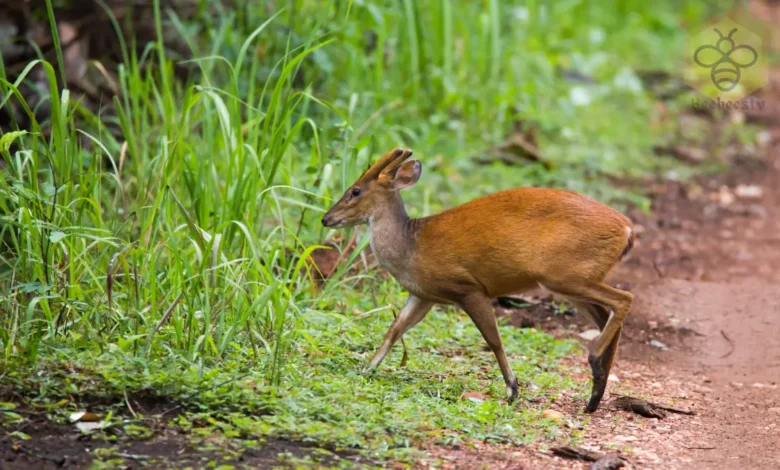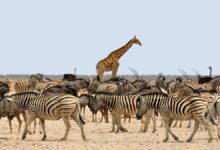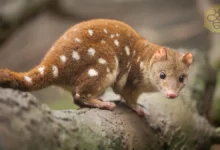Muntjacs: Habitat, Diet, Reproduction, Size, and more…

The Muntjac: An Ancient and Unique Deer Species
Muntjac
Introduction
The muntjac, also known as the barking deer, is a small yet fascinating deer species that has roamed the forests of Asia for millions of years. Known for their distinctive barking sounds and small stature, muntjacs are among the oldest deer species in existence.
Scientific Name
The scientific name for muntjac deer is Muntiacus, which is the genus under which various species of muntjac are classified.
Common Name
The common name for this deer is “muntjac,” though it is also commonly referred to as the “barking deer” due to its dog-like vocalizations.
Scientific Classification
| Kingdom | Animalia |
| Phylum | Chordata |
| Class | Mammalia |
| Order | Artiodactyla |
| Family | Cervidae |
| Genus | Muntiacus |
Types of Muntjacs
There are about 12 known species of muntjac, with the most commonly recognized ones including:
- Indian Muntjac (Muntiacus muntjak): Also known as the red muntjac, this species is native to South and Southeast Asia.
- Reeves’s Muntjac (Muntiacus reevesi): Native to China and Taiwan, this species has been introduced to the UK.
- Bornean Yellow Muntjac (Muntiacus atherodes): A species found on the island of Borneo.
- Fea’s Muntjac (Muntiacus feae): Found in Thailand and Myanmar, this species is relatively rare.
- Gongshan Muntjac (Muntiacus gongshanensis): A species found in China and Myanmar.
Habitat
Muntjacs are native to various parts of Asia, including countries like India, China, Taiwan, and Indonesia. They thrive in:
- Tropical and subtropical forests: Muntjacs prefer dense vegetation, which offers protection from predators and provides ample food sources.
- Woodlands and grasslands: These deer can also be found in deciduous woodlands, hilly areas, and even near human settlements.
Some species, such as the Reeves’s muntjac, have been introduced to other regions, including the UK, where they have adapted to woodlands and parklands.
Physical Characteristics
Muntjacs are small deer with distinct features that set them apart from other deer species:
- Size: Muntjacs are among the smallest deer species, standing 15–26 inches (40–65 cm) at the shoulder. They weigh between 33–66 pounds (15–30 kg).
- Color: Most species have reddish-brown or dark brown coats, though the exact coloration varies depending on the species and region.
- Antlers: Male muntjacs possess small, backward-curving antlers that grow from long pedicles. These antlers are shed and regrown each year.
- Canine Teeth: One of the most unique features of the muntjac is its elongated canine teeth, which are particularly prominent in males. These tusk-like teeth are used for fighting and self-defense.
- Barking Vocalization: Muntjacs are known for their loud barking sounds, particularly when they feel threatened, which has earned them the nickname “barking deer.”
Diet
Muntjacs are herbivores and primarily feed on a variety of plant-based foods. Their diet includes:
- Leaves and grasses: Muntjacs graze on grasses and browse on leaves from shrubs and trees.
- Fruits and berries: They also consume fruits and berries that fall to the forest floor.
- Bark and shoots: During periods when food is scarce, muntjacs may feed on bark, tender shoots, and twigs.
Unlike some other deer species, muntjacs are not picky eaters and can adapt to different food sources based on their environment.
Predators and Threats
Muntjacs, being small and relatively defenseless, face several natural predators and human-induced threats:
- Natural Predators: In their native habitat, muntjacs are preyed upon by larger carnivores such as leopards, tigers, and wild dogs. Birds of prey may also target muntjac fawns.
- Human Threats: Habitat loss due to deforestation and human development is a significant threat to muntjac populations. In some regions, they are also hunted for their meat and hides.
- Invasive Species: In areas where muntjacs have been introduced, such as the UK, they are considered an invasive species due to their impact on local ecosystems.
Reproduction, Babies, and Lifespan
Muntjacs have a relatively short gestation period compared to other deer species:
- Mating and Gestation: They do not have a fixed breeding season, allowing them to mate and reproduce year-round. The gestation period lasts around 6 to 7 months, after which a single fawn is born.
- Fawns: Newborn muntjac fawns are well-developed and can stand and walk within hours of birth. They remain hidden in dense vegetation for the first few weeks of life.
- Lifespan: In the wild, muntjacs typically live around 10 to 15 years, although they can live longer in captivity.
Population
The population status of muntjacs varies by species. While some species, like the Reeves’s muntjac, have stable or increasing populations due to their adaptability, others are more vulnerable due to habitat loss and hunting. The Bornean yellow muntjac, for example, is considered to be at risk due to deforestation in its native habitat.
Behavior and Lifestyle
Muntjacs are solitary animals, with each individual maintaining its territory. They are generally shy and elusive, preferring to stay hidden in dense vegetation.
- Territoriality: Males are particularly territorial and use their tusks and antlers to defend their range from other males.
- Activity Patterns: Muntjacs are most active during the early morning and late evening, though they can be active at night as well. They use their keen sense of smell and hearing to detect predators.
- Barking: The barking vocalization is not only used to signal danger but also as a means of communication between individuals.
Ecological Role
As herbivores, muntjacs play an essential role in their ecosystems by helping to control vegetation growth. They are also a prey species for larger predators, contributing to the balance of the food chain. In areas where muntjacs have been introduced, they have had mixed effects on the local environment, sometimes negatively impacting native plant species.
FAQs About Muntjac Deer
- What is a muntjac?
A muntjac is a small species of deer native to Asia, known for its barking sound and small size. - Where are muntjacs found?
they are native to parts of South and Southeast Asia but have also been introduced to the UK. - What do muntjacs eat?
They are herbivores and eat leaves, grasses, fruits, and berries, among other plant materials. - Is Muntjac dangerous?
While muntjacs are generally shy and non-threatening, males can be aggressive during the mating season and may use their tusks to defend themselves. - Do muntjacs bark like dogs?
Yes, they produce a barking sound, particularly when they feel threatened or alert others to potential danger.
Conclusion
The muntjac is a unique and ancient species of deer, with fascinating traits that set it apart from other members of the Cervidae family. Known for their small size, distinctive bark, and territorial nature, muntjacs play an essential role in their ecosystems. While some species thrive, others are at risk due to habitat loss and hunting. It is crucial to protect these animals and ensure their continued survival in both their native and introduced environments.


